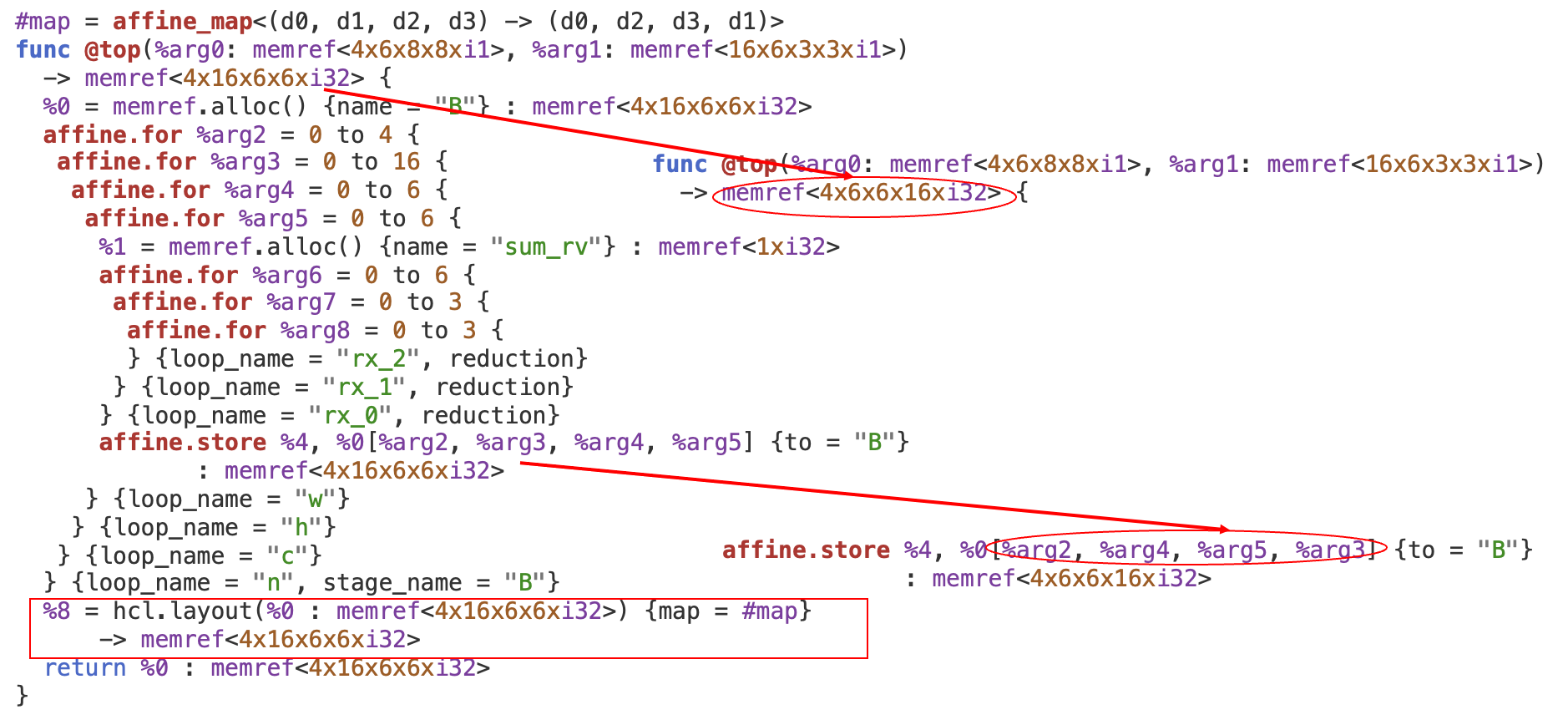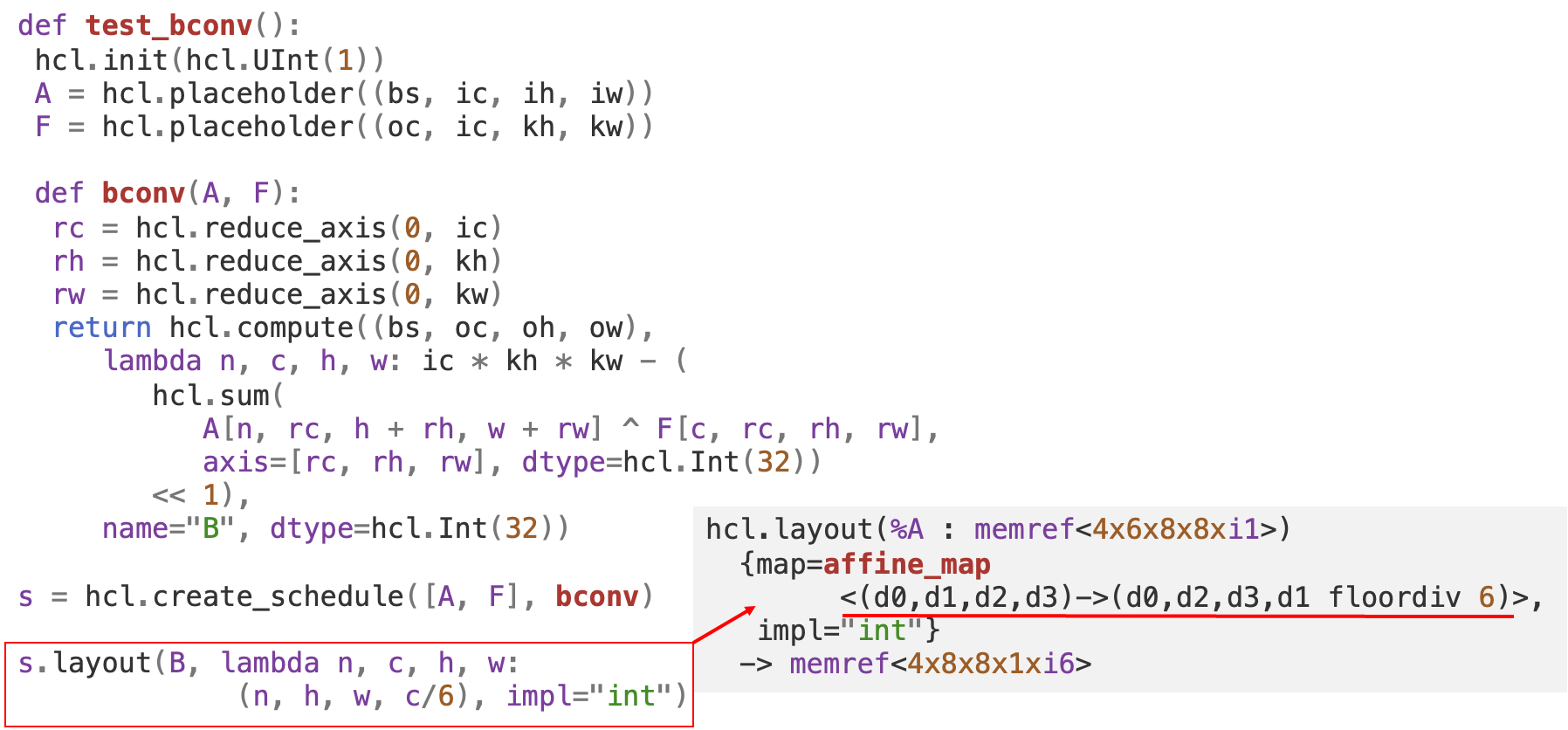You signed in with another tab or window. Reload to refresh your session.You signed out in another tab or window. Reload to refresh your session.You switched accounts on another tab or window. Reload to refresh your session.Dismiss alert
Data layout is an important problem that requires organizing data into memory. Traditionally, Struct of Arrays (SOA) and Arrays of Struct (AOS) are two popular choices to map multiple arrays to memory. Considering nowadays big data and deep learning workload consisting of high-dimensional arrays, data layout is not just about the organization of multiple structures, but also about the placement of different dimensions in a tensor.
Existing libraries or compilers do have interface to support layout customization, but they are not flexible enough to support different workloads -- their specification always couple with computation and is hard to change the layout without rewriting the algorithm. Numpy uses .transpose() to change the dimensions of an array, but it does not change the physical location of the data and only changes the strides.
numpy.transpose(array, (0,3,1,2))
Intel oneDNN uses dnnl::memory::format_tag to specify the tensor layout, but it is hard-coded in the algorithm implementation. Users cannot easily change it unless they rewrite the library function.
TVM decouples the layout and provides a ConvertLayout Pass for users to pass in their desired layouts of the tensors 1, but the layouts are attached to operators, and users cannot specify the layout of arbitrary tensors (e.g. intermediate arrays inside an operation).
There are also some specific challenges for FPGA to specify data layouts. First, FPGA can support arbitrary bitwidth data types, but not only 8/16/32/64 that are supported by CPU/GPU, which brings more choices when customizing the layout. Second, the memory space of FPGA is not monolithic but can be partitioned into different memory banks. Later on, we may want to unify the partition primitive and the layout one since partitioning an array is actually changing its layout.
We can summarize the issues listed below:
Productivity: Changing layout always requires to rewrite the whole program, including changing the loop bounds & memory accesses. It also introduces lots of library functions like conv2d_NCHW, conv2d_NHWC, and conv2d_NCHWc, which may mess up the library.
Performance: Coupled layout prevents further optimization. A common optimization choice involves using row-major or column-major storage for GEMM. Optimizing binary neural networks also needs to change the layout (bitpacking) which cannot be easily achieved by loop reordering.
Portability: Specific layout may be good on one device but not others. Nowadays different deep learning frameworks use different formats for backend implementation (e.g., PyTorch uses NCHW, and TensorFlow uses NHWC). Previous research shows the nChw16c layout may be good for CPU 2, but it is not sure whether 16 is the best packing factor for GPU and FPGA.
To solve the above challenges, we decouple the layout customization from computation and propose the hcl.layout primitive. For the Python frontend, we support the following formats:
s.layout(<tensor>, <LayoutEnum>)
s.layout(<tensor>, <LayoutMap>, <Implementation>)
The following example shows a binary convolution kernel written in NCHW format. By adding the s.layout(B, hcl.DenseLayout.NHWC) operation, we change the layout of tensor B to NHWC as a part of our compilation pass. Here NHWC is a predefined enumeration value. Later on, we can also support sparse format using a similar notation like hcl.SparseLayout.CSR.
The generated MLIR code is shown below. There is an affine map attached to the layout operation, which specifies the mapping from the previous index space to the new index space. After applying this primitive, we can see the shape of tensor B and the indices both changed. Since layout only tells where to retrieve the data but not how to compute them, only changing the indices is fine and preserves the correctness. If users want to have a better locality on CPU, then they need to explicitly reorder the loops to ensure the traversal order is the same as the memory organization.
The second format is to pass in a lambda function that explicitly specifies the layout. The following example shows changing the layout to NHW(C6) with the last channel dimension packed. The data type is also changed in this case.
Users can also pass in the impl parameter to specify which implementation they want to use. There are two different implementations for this packed layout. One is using the vector dialect, the other is using a large bitwidth integer. The differences are listed in the table below.
Vector
Large bitwidth integer
Interface
memref<4x8x8x1xvector<6xi1>> Can work for floating/fixed-point and large numbers of elements
Currently, we still load/store the data element by element, but in the end, we need to fully vectorize the code with vectorized computation.
Footnotes
Jared Roesch, Steven Lyubomirsky, Logan Weber, Josh Pollock, Marisa Kirisame, Tianqi Chen, Zachary Tatlock, Relay: A New IR for Machine Learning Frameworks, MAPL, 2018 ↩
Yizhi Liu, Yao Wang, Ruofei Yu, Mu Li, Vin Sharma, and Yida Wang, Optimizing CNN model inference on CPUs, ATC, 2019 ↩
The text was updated successfully, but these errors were encountered:
Data layout is an important problem that requires organizing data into memory. Traditionally, Struct of Arrays (SOA) and Arrays of Struct (AOS) are two popular choices to map multiple arrays to memory. Considering nowadays big data and deep learning workload consisting of high-dimensional arrays, data layout is not just about the organization of multiple structures, but also about the placement of different dimensions in a tensor.
Existing libraries or compilers do have interface to support layout customization, but they are not flexible enough to support different workloads -- their specification always couple with computation and is hard to change the layout without rewriting the algorithm. Numpy uses
.transpose()to change the dimensions of an array, but it does not change the physical location of the data and only changes the strides.Intel oneDNN uses
dnnl::memory::format_tagto specify the tensor layout, but it is hard-coded in the algorithm implementation. Users cannot easily change it unless they rewrite the library function.TVM decouples the layout and provides a ConvertLayout Pass for users to pass in their desired layouts of the tensors 1, but the layouts are attached to operators, and users cannot specify the layout of arbitrary tensors (e.g. intermediate arrays inside an operation).
There are also some specific challenges for FPGA to specify data layouts. First, FPGA can support arbitrary bitwidth data types, but not only 8/16/32/64 that are supported by CPU/GPU, which brings more choices when customizing the layout. Second, the memory space of FPGA is not monolithic but can be partitioned into different memory banks. Later on, we may want to unify the
partitionprimitive and thelayoutone since partitioning an array is actually changing its layout.We can summarize the issues listed below:
conv2d_NCHW,conv2d_NHWC, andconv2d_NCHWc, which may mess up the library.NCHW, and TensorFlow usesNHWC). Previous research shows thenChw16clayout may be good for CPU 2, but it is not sure whether16is the best packing factor for GPU and FPGA.To solve the above challenges, we decouple the layout customization from computation and propose the
hcl.layoutprimitive. For the Python frontend, we support the following formats:s.layout(<tensor>, <LayoutEnum>)s.layout(<tensor>, <LayoutMap>, <Implementation>)The following example shows a binary convolution kernel written in
NCHWformat. By adding thes.layout(B, hcl.DenseLayout.NHWC)operation, we change the layout of tensorBtoNHWCas a part of our compilation pass. HereNHWCis a predefined enumeration value. Later on, we can also support sparse format using a similar notation likehcl.SparseLayout.CSR.The generated MLIR code is shown below. There is an affine map attached to the

layoutoperation, which specifies the mapping from the previous index space to the new index space. After applying this primitive, we can see the shape of tensorBand the indices both changed. Since layout only tells where to retrieve the data but not how to compute them, only changing the indices is fine and preserves the correctness. If users want to have a better locality on CPU, then they need to explicitly reorder the loops to ensure the traversal order is the same as the memory organization.The second format is to pass in a lambda function that explicitly specifies the layout. The following example shows changing the layout to

NHW(C6)with the last channel dimension packed. The data type is also changed in this case.Users can also pass in the
implparameter to specify which implementation they want to use. There are two different implementations for this packed layout. One is using thevectordialect, the other is using a large bitwidth integer. The differences are listed in the table below.memref<4x8x8x1xvector<6xi1>>Can work for floating/fixed-point and large numbers of elements
memref<4x8x8x1xi6>%a_vec = affine.load %A[%n, %h, %w, %c floordiv 6]%a = vector.extractelement %a_vec[%c mod 6] : vector<6xi1>%a_int = affine.load %A[%n, %h, %w, %c]%a = hcl.get_bit(%a_int, %c mod 6) -> i1%a_new = vector.insertelement %sum, %c_vec[%c mod 6] : vector<6xi1>affine.store %a_new, %A[%n, %h, %w, %c floordiv 6] : memref<4x8x8x1xvector<6xi1>>%a_new = hcl.set_bit(%a_int, %c mod 6)affine.store %a_new, %A[%n, %h, %w, %c] : memref<4x8x8x1xi6>Currently, we still load/store the data element by element, but in the end, we need to fully vectorize the code with vectorized computation.
Footnotes
Jared Roesch, Steven Lyubomirsky, Logan Weber, Josh Pollock, Marisa Kirisame, Tianqi Chen, Zachary Tatlock, Relay: A New IR for Machine Learning Frameworks, MAPL, 2018 ↩
Yizhi Liu, Yao Wang, Ruofei Yu, Mu Li, Vin Sharma, and Yida Wang, Optimizing CNN model inference on CPUs, ATC, 2019 ↩
The text was updated successfully, but these errors were encountered: